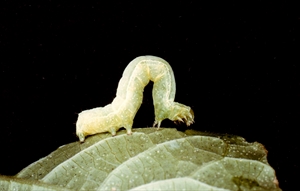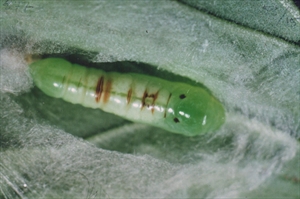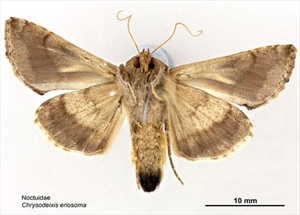Green looper caterpillar, green garden looper. In Fiji, this has been called the green semi-looper. In this fact sheet it is called the 'tomato green looper'.
Pacific Pests, Pathogens and Weeds - Online edition
Pacific Pests, Pathogens & Weeds
Tomato green looper (333)
Chrysodeixis eriosoma; the identification of this moth in the Pacific may have been confused with a similar ('sister') moth, Chrysodeixis chalcites, which in Fiji is listed by Swaine (1971)1 as Plusia chalcites. However, CABI (2014) lists no records of Chrysodeixis chalcites in the Pacific islands (it is in Australia and New Zealand), and quotes (Zang 1994): "Literature referring to C. chalcites (= chalcytes) in southern or eastern Asia or Oceania actually refers to C. eriosoma". However, the SPC surveys of Federated States of Micronesia and Palau record Chrysodeixis chalcites in Palau and the Northern Mariana Islands2.According to the entry in Wikipedia, the two species cannot be separated morphologically, but they can be separated based on DNA, response to pheromones and distribution. These moths are member of the Noctuidae.
Asia, North (Hawaii) and South America (Chile), Europe, Oceania. It is recorded from Australia, Fiji1, New Zealand, Papua New Guinea, and Tonga.
Wide. The larvae feed on plants in the daisy (Asteraceae), brassica (Brassicaceae, potato (Solanaceae), cucumber (Cucurbitaceae), legume (Fabaceae) and corn (maize) (Poaceae) families, and many more. Many ornamentals and weeds in these families are hosts, too. In Fiji, it is a pest on tomato, dwarf beans and cocoa seedlings in the nursery.
Larvae eat holes in leaves and shallow pits in fruits. Early larval stages do not eat all the way though the leaves, creating 'windows'; later stages make holes in the leaves, and, when numerous, defoliate plants and damage flowers and fruits.
Eggs are laid singly or in batches on the underside of leaves. The larvae are up to 40 mm long, blue-green, with several narrow white lines along their bodies. As they have only two prolegs on the abdomen, they move by looping (Photo 1). Pupation is within a silken cocoon spun by the larvae attached to objects in the soil, on the underside of leaves, or the folded edges (Photo 2). The adult is dark grey-brown, with silvery patches on the forewings and two white spots, and a wingspan of 30-40 mm (Photos 3-5). On the head, there are bunched hairs which look like a pair of short horns.
According to CABI, the moth is considered a serious horticultural pest (New Zealand), a pest of soybean (Australia and Indonesia), and a pest of cabbages in the USA (Hawaii).
Look for the larvae on the upper and lower surfaces of leaves. Look for damage, such as leaves with 'windows', holes through the leaves, or leaves eaten at the margins. On tomatoes look for holes in the fruits. DNA sequencing is required to separate the two speces, Chrysodeixis eriosoma and Chrysodeixis chalcites.
NATURAL ENEMIES
A number of parasitoids have been reported, and two Copidosoma floridanum (encyrtid) and Cortesia rufricrus (braconid), imported into New Zealand with good results. Copidosoma truncatellus gives as high at 85% parasitism in Hawaii. In Hawaii, too, nuclear polyhedrosis virus is known to infect larvae of this moth.
CULTURAL CONTROL
Recommendations for brassicas are the same as those provided for other moths that form part of the cabbage caterpillar complex, i.e., diamond back moth, cabbage heart-centre caterpillar, cabbage webworm (see Fact Sheets nos. 20, 78, 114). These suggestions can be used to guide growers when planting other crops.
Before (field) planting:
- Check seedlings in the nursery for egg masses and young caterpillars; if found, remove the leaves or the entire plants and destroy them.
- Use mustard (Brassica juncea) or Chinese cabbage as trap crops, planting it as a companion between rows of cabbages and other brassica species. Mustard is a preferred host for this insect pest and protects the cabbages from destruction. Plant the first row of mustard about 15 days before transplanting the cabbages, and the second row about 25 days after transplanting.
- Plant far from old plots of brassicas to prevent infestation from previous plots.
During growth:
- Handpick caterpillars from plants in the field when numbers of insects are low.
- Grow plants under nets or in screen houses, if resources allow.
After harvest:
- Collect and destroy crop debris after harvest.
CHEMICAL CONTROL
- Use plant-derived products, such as neem, derris, pyrethrum and chilli (with the addition of soap), or synthetic products that contain disease-causing organisms, such as spinosad (Success) and Bt - Bacillus thuringiensis subspecies kurstaki (Bt).
- If using Bt (Bacillus thuringiensis), note the following:
- The spray needs to be applied carefully so that there is good coverage of the plant as the insecticide has to be eaten by the caterpillars to kill them.
- Eggs are not susceptible to Bt.
- Small larvae are more susceptible to Bt than fully grown ones.
- Use Bt as soon as damage is seen.
- Avoid using broad-spectrum insecticides (such as pyrethroids and organophosphates) as they will kill natural enemies.
____________________
When using a pesticide (or biopesticide), always wear protective clothing and follow the instructions on the product label, such as dosage, timing of application, and pre-harvest interval. Recommendations will vary with the crop and system of cultivation. Expert advice on the most appropriate pesticide to use should always be sought from local agricultural authorities.
AUTHOR Grahame Jackson
1Information from Swaine G (1971) Agricultural Zoology in Fiji. Her Majesty's Stationery Office. London; and CABI (2014) Chrysodeixis eriosoma (green looper caterpillar) Crop Protection Compendium. (https://www.cabi.org/cpc/datasheet/13244); and Chrysodeixis eriosoma (Doubleday) (1991) Crop Knowledge Master Department of Entomology, Honolulu, Hawaii. (http://www.extento.hawaii.edu/kbase/crop/Type/chrysode.htm), and from 2Nafus DM (1997) An insect survey of the Federated States of Micronesia and Palau. South Pacific Commission, New Caledonia. Photo 1 Courtesy of Don Herbison-Evans, Macleay Museum, University of Sydney. (http://lepidoptera.butterflyhouse.com.au/plus/eriosoma.html). Photo 2 Merlin Crossley, UNSW, Sydney. Photo 3 Chrysodeixis eriosoma. Wikipedia. (https://en.wikipedia.org/wiki/Chrysodeixis_eriosoma#Adult). Photos 4&5 MAF Plant Health & Environment Laboratory (2011) Green Garden Looper (Chrysodeixis eriosoma). PaDIL -(http://www.padil.gov.au).
Produced with support from the Australian Centre for International Agricultural Research under project PC/2010/090: Strengthening integrated crop management research in the Pacific Islands in support of sustainable intensification of high-value crop production, implemented by the University of Queensland and the Secretariat of the Pacific Community.








